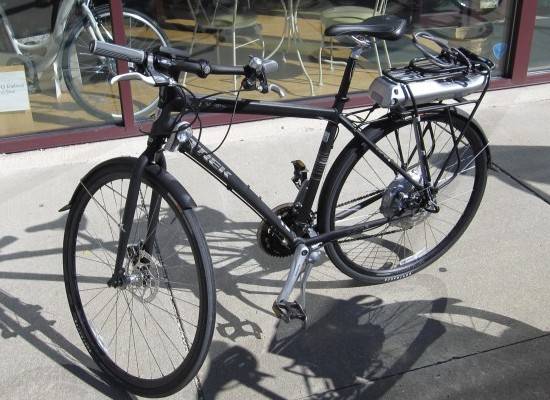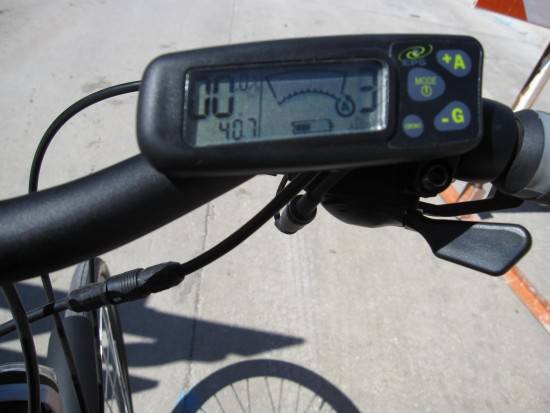
Ever since I took a job in Gibson City a couple of months ago, I’ve been pretty interested in electric-assist bicycles (mainly because it’s a long ways away and I haven’t figured out how to get a tailwind on the way home from work), but I’d never had the opportunity to ride one. So, when Peter Davis from Champaign Cycle emailed Smile Politely World Headquarters and wondered if we’d like to take one of their e-bikes for a spin during their Eco-Tour last Saturday, I jumped at the opportunity.
THE BIKE
The bike was a Trek Valencia + (the + is short for “electricity”), which retails for $2,399, but is on sale for $1,949 because people like me have been taking it for test rides. If you click the link above, you can check out the specific componentry. As you can see in the picture at the top of the article, it has a rear rack with a rectangular battery, which drives the BionX rear hub.
It’s a nice 24 speed commuter-level bike with trigger shifters, disc brakes, and front and rear lights. It’s an aluminum frame with steel fork, which helped keep the weight in line somewhat. I ride a 1970s Schwinn Suburban with baskets for my around-town beater, and the Trek was a similar weight (probably around 40 pounds). Since it’s a little top-heavy with the battery, a double kickstand is provided, which I found to be very sturdy.
Pictured below is the control panel for the motor, which is mounted on the right handlebar:

HOW DOES IT WORK?
There are four levels of battery assistance, and four levels of recharging, where the bike is more difficult than normal to pedal. The electric motor doesn’t kick in unless you’re pedaling. In the lowest level of assistance, the motor adds about 25% to your pedaling effort, at level 2, it adds about 50%; at level 3, it adds 100% or doubles your effort; and at level 4, it adds 200%. As you’d expect, the higher the level of assistance, the shorter the battery life. The motor literature claims a range of about 55 miles on assistance level 1, and I believe that level 2 will get you about 35 miles, and down to about 10 miles on level 4.
Even though I wasn’t going to be riding far enough to completely drain the battery, I tried the highest generation setting just for fun, and I could manage about five miles an hour on flat ground at max effort. A true masochist could probably recharge the battery without plugging it in, but it wasn’t very tempting to me.
The rear hub features regenerative braking, as well, which may help a little bit with battery life, especially if the bike were used for around-town commuting rather than longer, uninterrupted rides.
THE TEST RIDE
The Eco-Tour began at B. Lime in downtown Champaign, and spiraled outward from there to northeast Urbana and then returned, for a total of 18-plus miles.
I tried riding the bike without any assistance from the motor for a few blocks to get a feel for it. The Valencia + certainly felt heavy, as you’d expect, but it was a smooth, quiet ride and was well put-together. I was also a disc-brakes newbie, and I was impressed with the stopping power. Biking on brick streets is never pleasant under any circumstances, but the frame dampened vibration pretty well for aluminum and the 35-mm tires were plenty wide to ride comfortably.
Assistance level 1 wasn’t especially noticeable while riding on flat ground, but level 2 was a significant boost. I tried riding with similar effort level with and without assistance, and by my unscientific means, it seemed like level 2 gave me a 2 to 3 mph increase in speed. I’d heard it compared to riding with someone pushing gently on your back, and I think that’s an apt description. Before trying out the bike, an aspect that I was concerned about was speed control in traffic. I was happy to find that the motor was surprisingly responsive to quick changes in pedaling effort; when I spotted stopped vehicles ahead and started to coast, the hub immediately stopped assisting and my speed decreased quickly. I never felt like I was out-of-control or that the bike was driving me.
The big advantages to electric assistance, I found, were on hills, into a headwind, and accelerating from intersections. For example, I rode up the overpass over I-74 on High Cross into the wind at 18 to 19 mph (on level 4), where my unassisted speed probably would have been more like 10-12. On assistance level 2, I was able to maintain 15-16 mph into about a 10 mph headwind on flat ground, which was a nice boost. And beginning with level 2, there’s some real help to be had for getting across busy intersections. On level 4, it’s a real big help. The only criticism I had was that under higher-torque applications, especially taking off from a stop on level 4, the bike would vibrate fairly significantly. It wasn’t any big deal, but worth noting.
Top speed was right around 20 mph, regardless of assistance level. On level 4, I felt some sort of governor kick in when I reached 20-22 mph which kept me from exceeding that speed.
I returned to B. Lime with about a half-charge remaining on the battery.
THE VERDICT
After riding the Valencia +, I have to say that any concerns that I came in with were allayed. It was fun and really helped.keep my spirits up while bucking the headwinds outside of town. And it was a great feeling to zip up hills that would normally grind me to a crawl. I’m going to start saving my pennies to purchase some sort of electric-assist bike, which will allow me to commute to work by bicycle on a more regular basis. I think that it could be helpful for anyone who would like to ride farther and faster than they currently are able.








